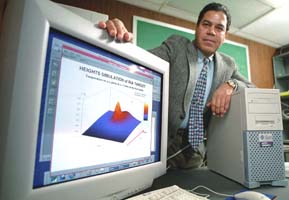University physician utilizing Argonne software designed to study energy beams
Evelyn BrownArgonne National Laboratory
The proposed Rare Isotope Accelerator at Argonne National Laboratory will provide nuclear physicists with an unprecedented variety of beams of short-lived radioactive elements, many at intensities more than 100,000 times those currently available. These beams also will produce high heat levels.
 Ahmed Hassanein, manager of the Computational Physics and Hydrodynamics Section in Argonne’s Energy Technology Division, is one of the Argonne National Laboratory researchers who is collaborating with Raphael Lee, Professor in Surgery at the University. |
The accelerator’s ion beams will be used to study the origin of the elements and test current models of physics, but the intensity of the beams’ heat levels would destroy their targets, which are typically made of thin films. To ensure that target materials can withstand the high-heat loads, RIA’s beam target and cooling system are being designed with an Argonne-developed software package––High Energy Interaction with General Heterogeneous Target Systems––that has become the international standard for simulating material behavior under intense energy exposure.
“We designed HEIGHTS to simulate the physics of intense energy and power deposition on targets,” said Ahmed Hassanein, manager of the Computational Physics and Hydrodynamics Section in Argonne’s Energy Technology Division.
In collaboration with Rafael Lee, Professor of Surgery in the University’s Surgery and Brain Research Institute, Argonne researchers are using HEIGHTS to study electric arcs, their propagation through the atmosphere and their interaction with human bodies. Physicians hope to learn how to improve patient treatment and upgrade equipment.
The software simulates such phenomena as shock and ignition physics, heat and radiation propagation through the atmosphere and photon transport through different media. Hassanein and his colleagues are using it to evaluate light- and heavy-ion beam interaction with targets to calculate the thermal response of different target systems cooled by liquid metals.
In Europe, Japan, Russia and the United States, the software has been used extensively to model plasma-material interactions in laboratory devices and fusion machines. The intense heat of the plasma in magnetic-confinement fusion reactors ––approximately 100 million degrees Kelvin–– severely challenges designers. The software program simulates the plasma’s interaction with reactor materials to determine what materials can withstand the plasma and photon radiation and how long they will last in a fusion reactor.
High-energy physicists at Fermilab and Brookhaven National Laboratory use the software to model the targets for a muon collider and neutrino factory. Other researchers use the software to model high-velocity liquid-metal jets in strong magnetic fields and to study the shock hydrodynamic effects from proton beam bombardment.
Depending on the complexity of a problem, running times can range from as short as one hour to as long as several months. The software is continuously updated and upgraded to incorporate new state-of-the art physics and numerical solution methods.
The University operates Argonne National Laboratory for the U.S. Department of Energy.
![[Chronicle]](/images/small-header.gif)